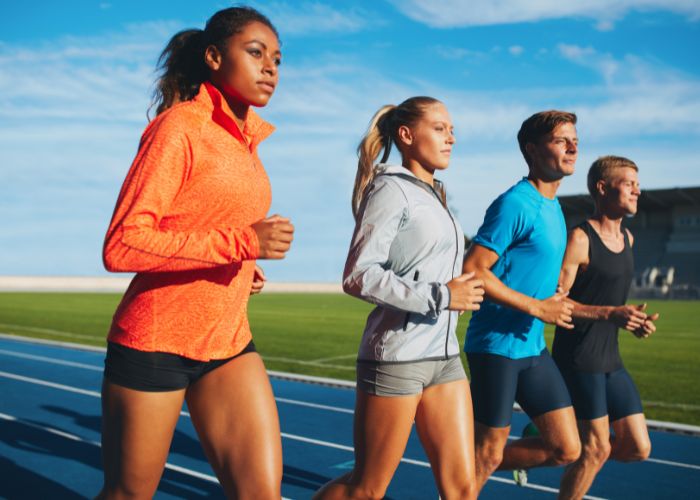Discover the best sports fabrics
The world of sports fabrics
The world of sports is constantly evolving, and with it, the materials that enable athletes to perform at their best. Among these, sports fabrics play a crucial role, offering not only comfort but also improved efficiency in sports practice. The right choice of fabric can significantly influence performance, endurance, and comfort during exercise.
In this article, we will explore the best sports fabrics available in the market, highlighting their unique features and how they can enhance your sports experience. By understanding the properties of different sports fabrics, you can make informed decisions for your athletic needs, thus ensuring an optimal sports experience.


Types of sports fabrics
When we talk about sports fabrics, we refer to a wide range of materials specifically designed to meet the demands of exercise and physical activity. One of the most common is polyester, known for its durability and resistance to wrinkles and shrinkage. Polyester also stands out for its quick-drying capability, making it ideal for water sports or high-impact activities where perspiration is considerable.
Another frequent material is spandex, also known as lycra, characterized by its exceptional elasticity. This property makes it perfect for sports that require a great range of motion, such as yoga or gymnastics. Additionally, spandex is often combined with other fabrics to add elasticity to garments.
Nylon, on the other hand, is another favorite in the sports industry. This material is lightweight, strong, and dries quickly, making it ideal for outdoor clothing and camping equipment. Moreover, its resistance to wear makes it an excellent choice for adventure sports.
Technical fabrics for sportswear
Technical fabrics are the backbone of modern sportswear, offering advanced solutions for athletes in all conditions. These fabrics go beyond basic functionality, incorporating properties such as:
- Waterproof and Wind Resistance: Essential for outdoor sports, these fabrics protect against the elements, keeping the athlete dry and comfortable.
- UV Protection: For sports practiced under the sun, these fabrics offer a crucial barrier against harmful UV rays.
- Temperature Control: Some technical fabrics are designed to keep the body at an optimal temperature, either cooling or retaining heat as needed.
- Durability and Wear Resistance: These fabrics are designed to withstand extreme conditions and intense use, making them ideal for adventure sports and rigorous activities.

Choosing the right fabric according to the sporting activity
Selecting the correct fabric according to the sport practiced is fundamental to ensure maximum comfort and performance. Here are some examples:
- Running and Athletics: Polyester is recommended for its lightness and quick-drying capacity. Ideal for long training sessions.
- Yoga and Pilates: Fabrics with high spandex content, like lycra, are preferred for their flexibility and comfort.
- Swimming: Nylon and spandex are ideal for their chlorine resistance and snug fit to the body.
- Cycling: Fabrics with compression and wind resistance, such as a mix of polyester and spandex, are suggested.
- Gym and Strength Training: Fabrics with high elasticity and wear resistance, like blends of polyester and spandex, are excellent for supporting intense and varied movements.
- Winter Sports: Insulating and water-resistant materials, such as fleece and specialized synthetic fabrics, are essential for maintaining warmth and dryness.

Each sport has its own needs, and choosing the right fabric can make a significant difference in your experience and performance.
Care and maintenance of sports fabrics
Proper care of sports fabrics is essential to maintain their properties and extend their lifespan. Here are some important tips:
- Proper Washing: Wash sports garments in cold water to avoid damaging the fibers and integrated technologies. Avoid using fabric softeners, as they can affect breathability and moisture absorption.
- Drying: Avoid using a dryer whenever possible. Heat can deteriorate the elasticity and other properties of the fabric. Instead, let the garments air dry, but not under direct sunlight.
- Storage: Store sportswear in a cool, dry place. Avoid storing it damp to prevent odor and mold formation.
- Stain Treatment: Treat stains as soon as possible with specific products for sports fabrics, avoiding bleaches and other harsh chemicals.
Following these simple steps will help your sports garments maintain their functional and aesthetic qualities for longer.
Future trends in sports fabrics
The future of sports fabrics focuses on innovation and sustainability. We will see an increase in the use of recycled and biodegradable materials, responding to a growing demand for eco-friendly products. Additionally, the integration of smart technology in fabrics, such as sensors to monitor physical performance and health, will become more prevalent. There is also an expected advancement in customization, with fabrics that better adapt to the specific needs of each sport and athlete.
These innovations will mark a new era in sports garments, combining functionality, comfort, and environmental responsibility.

KILOTELA, your partner for sportswear manufacturing
In summary, choosing the right sports fabric is essential for optimal performance, comfort, and durability in sports practice. From polyester to spandex, each material offers unique features suited to different athletic needs. With the advancement of technologies and growing ecological awareness, the future of sports fabrics is oriented towards innovation and sustainability.
We invite you to explore and choose the best sports fabrics for your activities at KILOtela, ensuring not only better performance but also a greater contribution to environmental care.




